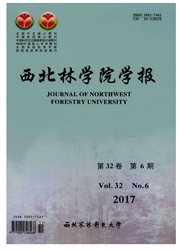

 中文摘要:
中文摘要:
晋西吕梁山基岩山地与黄土丘陵区生态过渡带的植被和土壤具有明显的过渡性和特殊性。以过渡带内黄土丘陵边缘区的油松人工林为对象,分别研究了油松人工林的合理经营密度、生物量和碳密度特征,并在此基础上分析了油松人工林生态系统的管理对策。应用标准样地调查资料,研究油松树冠面积与胸径的相关关系,并构建出拟合精度高(相关系数R=0.875 6)的模型:Y=0.762 4exp(0.166 4*X),其中,Y为树冠面积,X为径阶。应用上述模型,根据径阶计算理论树冠面积和理论密度,在此基础上考虑树冠重叠度的影响,作为理论密度修正,进而编制了不同郁闭度条件下的油松林分合理密度经营表。研究区域内油松人工林年龄范围在16~37a,乔木层生物量维持在39.97~110.93t·hm^-2,年均生产力范围在1.04~3.09t·hm^-2·a^-1,乔木层碳密度范围为19.99~55.47t·hm^-2,均低于全国其他气候相对湿润的油松产区。该地区油松人工林多存在初植密度过大的问题,经过几十年的生长,很多林分已经开始出现明显的退化特征,建议该地区应适时进行抚育间伐,间伐标准可参照林分生长现状及林分密度管理表来确定。
 英文摘要:
英文摘要:
The vegetations and soils of the ecotone between bedrock region and loess hill area of west Shanxi Province had obvious transitional and unique characteristics.Plantations of Pinus tabulaeformis occurring in the ecotone were studied from the aspects of rational management density,biomass,and carbon density.Then the management strategies of the plantations were proposed.Based on the data from the sampling plots of the plantations,the relationship between the crown area and the diameter at breast height(DBH)was analyzed,and the regression model with high fitting accuracy was set up as Y=0.762 4exp(0.166 4*X)(R=0.875 6).The table of theoretical density and suitable management density were established suiting for different canopy densities.The stand ages of P.tabulaeformis plantation were 16-37 ain the survey area.The tree layer biomass maintained in 39.97-110.93t·hm~(-2).The average annual productivity ranged from 1.04 to 3.09t·hm~(-2).The tree layer carbon density ranged from 19.99t·hm~(-2) to 55.47t·hm~(-2).The data above mentioned were slightly lower than those of other regions in China with relatively humid climate.The planting density of P.tabulaeformis plantations was too high in this area,after decades of growth,many stands began to present obvious degradation characteristics.It was recommended that the stand thinning should be done at least in the ages of 20 to 25-year.The thinning intensity could be based on the stand growth status and stand density management table.
 同期刊论文项目
同期刊论文项目
 同项目期刊论文
同项目期刊论文
 期刊信息
期刊信息
